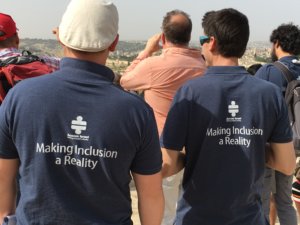Last May, as part of the amazing Access Israel conference, I got to “test” just how accessible the Old City of Jerusalem really is. Many conference attendees got off tour buses with lifts and traveled through the gates of the Old City, to the Church of the Holy Sepulcher, and on to the Western Wall. What an emotional moment seeing friends in wheelchairs wheeling themselves to Judaism’s most holy place! We were using the new Accessible JLM app. https://apps.apple.com/il/app/accessible-roads-jerusalem/id1434672106.
I knew the app and various informative articles (i.e. https://www.israel21c.org/jerusalems-old-city-now-accessible-to-people-with-disabilities/) said that Jerusalem was accessible. It wasn’t until I spent the day walking around the Old City with my new German journalist friend, Werner, wearing gloves and operating his wheelchair, that I learned that it is indeed accessible.
Imagine my excitement when we attended a “speed dating” event, hosted by Google Israel, leading up to the conference. The evening was a chance for each participant to quickly sample accessible apps and technologies. Three conference participants were commissioners on disabilities from major cities—New York, Chicago and New York—two were full time wheelchair users. It would only be a matter of time—we all hoped—when the world—beyond the walls of the Old City of Jerusalem—would become more accessible.
Fast forward one year. On May 21st, Global Accessibility Awareness Day, Google announced that Google Maps will now show places that are wheelchair accessible, and users will be able to find such places effortlessly without taking any extra steps. All they have to do is turn on the “Accessible Places” feature in their settings. (see coverage: https://assistivetechnologyblog.com/2020/05/google-maps-will-now-show-wheelchair-accessible-places.html; https://www.searchenginejournal.com/new-google-maps-feature-highlights-wheelchair-accessible-places/370054/#close).
Thank you, Google. The world has been needing this map for a long time. Now, people in wheelchairs, strollers, motorized scooters—and the rest of the world—will get around just a bit easier!





